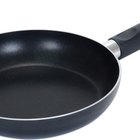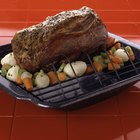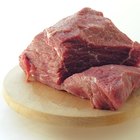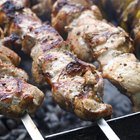Countertop roaster ovens can do many of the same things your regular oven does, but it isn't quite the same. For one thing, the smaller cooking space retains much of the moisture that would evaporate in a regular range or wall oven. That makes roasters ideal for chuck roasts and other tough cuts, which require long, slow cooking times. The roaster can be used to braise your chuck for pot roast, or slow-roast it in a moist atmosphere that limits evaporation.
Braising Your Chuck
Place the cooking insert in the roaster, plug it in, and preheat to 300 degrees Fahrenheit.
Heat a heavy skillet over a medium-high burner, and add a half-tablespoon of oil. Sear the chuck roast thoroughly on all sides, until it's well-browned. Season it liberally with salt and pepper, or other seasonings if desired, and transfer it to your roaster.
Return the skillet to its burner, and pour in a small amount of broth or wine. Stir it vigorously to dissolve the seared-on beef juices, then pour them over the chuck. Pour in enough additional broth, water, wine or other liquids to come halfway up the side of the roast.
Add onions, garlic, celery, carrots or other aromatic ingredients as desired. Turn down the roaster to a temperature of 250 F, and slow-cook the roast until it's fork-tender. For a 4- to 6-pound roast, this typically takes 2 to 3 hours. If you wish to cook vegetables with the roast, add them after the first hour.
Remove the finished pot roast from your roaster, and transfer it to a serving platter. Cover it loosely with foil, and let it rest for 10 to 15 minutes before serving. Lift out the vegetables, if you've made them, with a slotted spoon and transfer them to a serving bowl. Strain the cooking liquid, and thicken it to make a sauce. Serve the pot roast, vegetables and sauce together.
Slow-Roasting
Place the cooking insert into your roaster, plug it in, and preheat it to 350 F.
Sear the chuck on all sides, in a hot, heavy-bottomed skillet. This step is optional, but adds rich, savory flavors. Season the roast liberally with salt and pepper, or other flavorings as desired.
Transfer the browned chuck to your countertop roaster, adding onions or other aromatic ingredients if you wish. Cover the roaster, and reduce its temperature to 300 F.
Slow-roast the chuck until it reaches your desired degree of doneness. At approximately 20 minutes per pound, your chuck will be medium-well and will slice easily for sandwiches or a roast beef dinner. At 30 to 35 minutes per pound, it will have a rich, soft texture similar to pot roast or pulled pork.
Remove the chuck from your roaster and let it rest for at least 10 minutes before slicing and serving it.
Related Articles

How to Use an Electric Roaster to Slow ...
How to Cook a Seven Bone Pot Roast in ...

How to Cook a Deer Neck Roast in a Slow ...
How to Cook a Lamb Square Cut Shoulder

How to Cook Beef Top Round Pot Roast

How to Cook Prime Rib Using an Oven ...

How to Cook a Deer Brisket

Different Ways to Cook Chuck Roast Beef

How to Cook Center Cut Chuck Steak

How to Prepare Chuck Tender Roast

How to Cook Beef Shoulder Muscle
How to Cook a Choice Chuck Roast

How to Cook Venison With Tomatoes in a ...

How to Braise an Eye of Round

How to Cook a Beef Topside Roast

How to Cook a Beef Loin Tri Tip Steak ...

How to Make a Roast in an Electric Fry ...

How to Cook a Tender Lamb Breast

How to Convection Roast a Brisket
Cooking Guide for Semi-Boneless Beef ...
References
- Recipe Tips: Roaster Oven
- Nesco: 18-Quart Roaster Oven
- On Cooking: A Textbook of Culinary Fundamentals; Sarah Labensky, et al.
Tips
- Don't open the lid of your roaster unnecessarily, especially in the early stages of cooking. This lets out the heat, and can extend your cooking time by up to an hour.
Warnings
- To avoid burns, exercise caution when you're placing your roast in the roaster or removing it from the roaster. When you lift the roaster's lid, keep your hands clear to avoid being burnt by the hot steam as it escapes.
Writer Bio
Fred Decker is a trained chef and prolific freelance writer. In previous careers, he sold insurance and mutual funds, and was a longtime retailer. He was educated at Memorial University of Newfoundland and the Northern Alberta Institute of Technology. His articles have appeared on numerous home and garden sites including GoneOutdoors, TheNest and eHow.